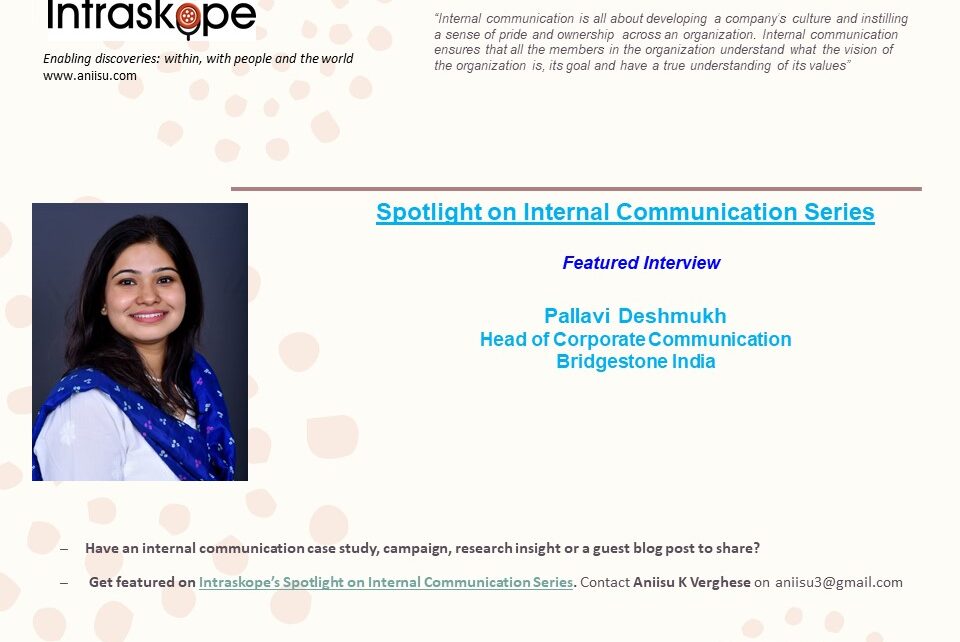Presenting the 47th edition of Intraskope’s Spotlight on Internal Communication Series featuring Pallavi Deshmukh of Bridgestone India. Pallavi heads Corporate Communications at the leading tire manufacturer and is a marketing and communications specialist, with over 17 years of experience in brand management, strategy and communication development.
She explains how to tailor communication to suit audience needs and the ability of balancing communication for improving connection to the purpose.
Watch the complete video interview on YouTube or read the transcript below.
Interview
1. What does internal communication mean to you?
For me, internal communication is all about developing a company’s culture and instilling a sense of pride and ownership across an organization. Internal communication ensures that all the members in the organization understand what the vision of the organization is, its goal and have a true understanding of its values. Internal communication for me is not only one way that is top down but, it should also enable a dialogue and conversation about topics that are important to build the organization culture and enable to strategy. It is all about ensuring that the last man standing in the organization understands where we are going, which road to take and how does he participate in that. Creating an open, inclusive and transparent communication across the organization is the key.
2. How is it practiced in your organization?
At Bridgestone India we have a strong focus on communications and more importantly internal communications as we believe that this enables achieve alignment across the organization. Having a common view of the organizational objectives and goals. We believe that when the strategy is clearly understood internally by all, execution becomes more efficient and helps drive results. We also believe this helps strengthen the team spirit and understanding of common goals. Living by our values and promoting the behaviors that we see are extremely critical to develop an organization culture. For us at Bridgestone the core objective of internal communications is to keep all our employees well informed about the developments and updated within the organization and have an open and transparent communication across level. And for us, it starts right at the top. Our leaders believe in this and encourage this. So, we use both conventional and technology driven methods to get the best of internal communications. From simple newsletters to tech driven town-halls, we use every tool as would be appropriate for the communication in today’s time. However, yes, it is evolving, and we need to participate in this journey as we go along.
3. Please share an example/campaign that you are personally proud of working on and that made a significant impact to an organization in the recent past
What comes to mind is the journey of developing communications as a function when I took up this role at Bridgestone India. The communication function was set up to strengthen the transformation journey that we are driving within Bridgestone and to partner with the leadership team on this. The objective here for internal communications was clearly to drive an open and transparent dialogue; ensure alignment to strategy; encourage bottom up and inclusive communication. We have in the past two years been successfully able to establish programs and initiatives to meet this objective and have institutionalized most of them. An important role here is the leadership commitment
4. What is the biggest challenge you face while going about managing internal communication?
One of the biggest challenges is the diversity of the company’s employee workforce, including expats. One must make sure that communication content is such that it is understood across the company, including international reporting, and that the cultural and local sensitivities are properly addressed. It is most important that the messages are simple enough and customized to the audience that is diverse.
5. What according to you is the biggest opportunity that internal communicators have?
The biggest opportunity that internal communicators have is an audience that is evolved and understands what can be achieved through internal communication. There is always a concern and view that it is either too much communication or too little. Again, this is about the view one has and engagement on the topic one has. The most important aspect here is to build a dialogue and conversation around topics that are strategically important to organization and ensure there is clarity and openness. Thanks to technology now we are able to connect with larger groups across geographies. Now, the audience is respective to even greater information more so about the workplace and with COVID, digital is the only way. It is an opportunity to keep employees across the company engaged in dialogue. The key word is dialogue is a key, internal communications cannot be one way. It is important to build bottom up and inclusive communication
6. How can internal communicators add more value to the business?
An informed employee force is a team with a sense of belonging and with this comes the pride of ownership… one of the greatest values that a business can strive to have and this can be achieved through internal communication. Translating business strategies into engaging communication that resonates with the employees creates a significant value for business.
7. What skills must they have or develop?
To be a partner to leadership and business it is extremely important to have an understanding to strategy, business and operation. A communication specialist needs to partner with business to translate strategies into communication that can be easily understood by various members in the organization. It needs to be empathetic and authentic. Communications professional need to be trusted partners to business team and leadership teams.
8. What is your advice for people who are keen to join internal communication and make a career?
It is a great profession and is an essential component of forward looking and pragmatic management. Having said that, my advice is – Be creative and be true to yourself and the organization. Integrity in communication is extremely important.
9. What is your advice for women who want to make a mark in this domain and what must they do differently?
Communication as a profession naturally offers itself well with women and that they can excel in this area. One can be extremely creative in this area, in my view women are good at stakeholder management and which is also a need of this role. While I say this, it is also important that in this role we must partner with the leadership team and business to be able to translate the strategies in engaging and empathic communication. While be open and transparent.
10. With COVID-19 and other crises, how must internal communications engage? What has changed or will change? Examples of how your organization has helped reassure employees and navigate the crisis as it unfolds.
Like with all other forms of internal communications; facts and truth are key. These attributes become more critical during a crisis and COVID has been one of the worst crises that the world has witnessed. Internal communicators must ensure that facts relating to employee health and safety are properly communicated. Internal communicators must also ensure that management uses all technological tools available to keep connected with the employee force. Senior management interaction at a time of crisis is very reassuring for teams.
11. Can you share one trend that you spot with internal communications?
One trend that I see is a greater use of technology. Empathetic and factual communication is become more critical. Audiences have evolved, with information that is available across it is so critical that communication needs to be routed and well anchored on the values and core of the brand, whether it is internal or external.
12. If there is one aspect of internal communications you would like to change, what would that be?
Not really, I truly believe that communication is an evolving area and we have seen so much change that has happened in the recent past. That communication will become more critical to business and organization. With the rapid changes that we see across, business models are changed and so our customer preferences and how people consume messages. So, there is a high degree of experimentation that is happening everywhere, so it is all about success and replicate or fail and learn in all this process internal communication will play a critical role.
Liked the interview? Post your comments and share it with your network.
Keen to contribute and participate in the ongoing series on Intraskope where we put the spotlight on thought leadership, great ideas, and practical solutions?
Look up the previous stories from organizations featured on the Intraskope’s Spotlight on Internal Communication Series here – Northern Trust, AXA Business Services, Subex, global insurer, Standard Chartered Bank, BASF, Applied Materials India, Microsoft UK, Times Group, Samsung, Falabella, Cisco, Brillio, UAE Exchange, Apeland, M.H. Alshaya Co, Proctor & Gamble, Infosys, SOBHA Ltd., ICICI Securities, First Advantage, CK Birla Group, TVS Motors, GE, Suzlon, Tata Sons, Percept, Knight Frank, TCS Europe, Vedanta, Oxfam, Danske Bank, Diageo, Pandora, Symantec, ISS Global Services, Telia, Thomson Reuters, IBM, General Motors, Intelligence India Software Solutions, Philips, Refinitiv, Mastercard, VFS Global and Ittiam Systems.
Intraskope (www.aniisu.com) is the first blog on internal communications in India and among the earliest around the globe. Begun in 2006, the blog has over 1000 posts on topics such as employee engagement, leadership communication and employee branding and receives thousands of visits from across the world. The blog, receives over 1,50,000 visits every month from over 50 countries globally, offers learning resources for practitioners, academicians, and students including industry workshops, research reports, and checklists.
Intraskope has been featured on leading global internal communication forums like Simply-Communicate, IC Kollectif and International Association of Business Communicators. It is hosted by Aniisu K Verghese, author of Internal Communications – Insights, Practices & Models (Sage, 2012).
If you are an internal communication leader working in a firm or a not-for-profit anywhere in the world and have an internal communication case study, campaign, research insight or a guest blog post to share please contact me on [email protected]
Here are Internal Communications resources you can use:
• Internal Communications Series: https://forms.gle/KcqmPzLwq7NQi5Km6
• Chat with Aniisu – Internal Communications: https://www.instamojo.com/intraskope/connect-with-aniisu-60-minute-personalized-d/?ref=store
• Internal Communications workshops: https://bit.ly/2zdBRl1
You can also visit my website www.intraskope.com and You Tube channel to know more about my work.
#listening #focus #connection #covid19 #accountability #experiences #change #accessibility #internalcommskills #skilling #ICskills #internalcomms #corporatecomms #internalcommunications #employeeexperience

